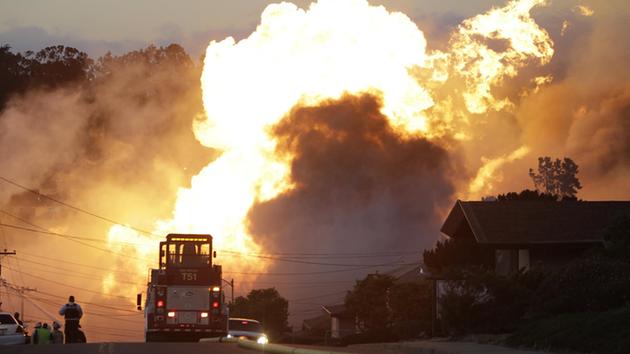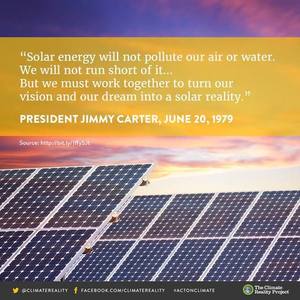On the closed landfill across from Valdosta State Prison on Val Tech Road, what looks like maybe a megawatt of solar panels by the City of Valdosta.

Pictures by John S. Quarterman for Lowndes Area Knowledge Exchange, 1 September 2017
On the closed landfill across from Valdosta State Prison on Val Tech Road, what looks like maybe a megawatt of solar panels by the City of Valdosta.

Pictures by John S. Quarterman for Lowndes Area Knowledge Exchange, 1 September 2017
Thirty-six years ago, Three Mile Island turned public opinion against nuclear power.
 The worst in history, right now still spewing after three months
and Los Angeles County and the state of California have declared emergencies
at Porter Ranch,
is the “natural” gas industry’s Three Mile Island.
The worst in history, right now still spewing after three months
and Los Angeles County and the state of California have declared emergencies
at Porter Ranch,
is the “natural” gas industry’s Three Mile Island.
Nuclear, too was touted as safe, clean, and infamously “too cheap to meter”. It turned out to be none of those things, and neither is fracked methane. Three Mile Island alone didn’t stop the thousands of nukes President Nixon promised, but it sure helped. The Porter Ranch disaster has already lasted far longer, had worse direct effects, and is in the nation’s second-largest metropolitan area.
 Plus TMI was the first U.S. civilian nuclear accident.
The “natural” gas industry has leaks, corrosion, fires, explosions, and now earthquakes monthly and sometimes daily.
Sure, the shadow of nuclear war hung over the nuclear power industry, but the monthly fireballs from methane explosions hangs over the natural gas industry.
The 2010 San Bruno, California explosion is back in the news because, says AP 13 January 2015:
PROSECUTORS: PG&E RESISTED RECORD-KEEPING CHANGE AFTER SAN BRUNO BLAST.
Plus TMI was the first U.S. civilian nuclear accident.
The “natural” gas industry has leaks, corrosion, fires, explosions, and now earthquakes monthly and sometimes daily.
Sure, the shadow of nuclear war hung over the nuclear power industry, but the monthly fireballs from methane explosions hangs over the natural gas industry.
The 2010 San Bruno, California explosion is back in the news because, says AP 13 January 2015:
PROSECUTORS: PG&E RESISTED RECORD-KEEPING CHANGE AFTER SAN BRUNO BLAST.
 It’s time for a complete moratorium on all new natural gas projects,
like the moratorium on all new nuclear projects after Three Mile Island.
Instead, let’s get on with what we didn’t have back then:
solar and wind power already less expensive than any other sources of power,
far cleaner and safer, much faster to deploy, using no water, and requiring no eminent domain.
It’s time for a complete moratorium on all new natural gas projects,
like the moratorium on all new nuclear projects after Three Mile Island.
Instead, let’s get on with what we didn’t have back then:
solar and wind power already less expensive than any other sources of power,
far cleaner and safer, much faster to deploy, using no water, and requiring no eminent domain.
In 1962 President John F. Kennedy famously said: Continue reading
U.S. president Jimmy Carter had a dream,
 thirty six years before Pope Francis spelled out why we all need to escape a dark hot nightmare,
and Jimmy Carter’s sunny dream is now coming true.
thirty six years before Pope Francis spelled out why we all need to escape a dark hot nightmare,
and Jimmy Carter’s sunny dream is now coming true.
Continue readingToday, in directly harnessing the power of the Sun, we’re taking the energy that God gave us, the most renewable energy that we will ever see, and using it to replace our dwindling supplies of fossil fuels.
My op-ed in the VDT today. -jsq
Continue readingGov. Deal (WABE, 14 Nov 2012) temporarily forgot that “conservative” includes conserving something,
like Theodore Roosevelt and national parks, or when Franklin D. Roosevelt established the Okefenokee National Wildlife Refuge which also administers Banks Lake, when Richard Nixon started the EPA, and when Jimmy Carter signed the Soil and Water Conservation Act. If Gov. Deal wants to call conservation “liberal”, I’m happy to be a liberal working for water for our state!
Georgia Water Coalition’s Dirty Dozen
listed the biggest boondoggle of all as #11: the nuclear reactors at Plant Vogtle suck up more water from the Savannah River than all local agriculture and almost as much as the city of Savannah.
If the new Plant Vogtle nukes are ever completed, all four will use more water than Savannah. In 2009 the legislature approved and Gov. Deal signed a law letting Georgia Power charge its customers in advance for building that boondoggle, to the tune of about $1.5 billion so far!
Let’s not forget
Norm Stanager wrote for YES! Magazine (via AlterNet) 17 November 2011, Police Chief Who Oversaw 1999 WTO Crackdown Says Paramilitary Policing Is a Disaster
Did anybody consider informing the protesters of the issues and asking for cooperation, or checking to see if there were alternate routes for emergency vehicles, or…. Hey, I’m not a professional emergency responder, but surely there must be a plan B in case some major intersection is out of commission due to a water main blowout, natural gas leak, earthquake, or whatever.Then came day two. Early in the morning, large contingents of demonstrators began to converge at a key downtown intersection. They sat down and refused to budge. Their numbers grew. A labor march would soon add additional thousands to the mix.
“We have to clear the intersection,” said the field commander. “We have to clear the intersection,” the operations commander agreed, from his bunker in the Public Safety Building. Standing alone on the edge of the crowd, I, the chief of police, said to myself, “We have to clear the intersection.”
Why?
Because of all the what-ifs. What if a fire breaks out in the Sheraton across the street? What if a woman goes into labor on the seventeenth floor of the hotel? What if a heart patient goes into cardiac arrest in the high-rise on the corner? What if there’s a stabbing, a shooting, a serious-injury traffic accident? How would an aid car, fire engine or police cruiser get through that sea of people? The cop in me supported the decision to clear the intersection. But the chief in me should have vetoed it. And he certainly should have forbidden the indiscriminate use of tear gas to accomplish it, no matter how many warnings we barked through the bullhorn.
My support for a militaristic solution caused all hell to break loose. Rocks, bottles and newspaper racks went flying. Windows were smashed, stores were looted, fires lighted; and more gas filled the streets, with some cops clearly overreacting, escalating and prolonging the conflict. The “Battle in Seattle,” as the WTO protests and their aftermath came to be known, was a huge setback—for the protesters, my cops, the community.
This article was published a few days before the UC Davis pepper spray events, but the author explicitly cites what happened to Scott Olsen in Oakland and the arrests in Atlanta, saying those are continuations of the same problems he experience in Seattle in 1999.
Then he gets into why: Continue reading
Not quite rolling his eyes when she mentions visiting communities, CCA’s video pair disparage community opposition to private prisons on their own web page, When Corrections Meets Communities:
Hm, you mean like some of the material on this blog?Question: There are Web sites and blogs that are adamantly opposed to your company and industry, and they provide negative information about you. Why?
Answer: CCA and all corrections companies recognize the ongoing efforts of local, loosely formed grassroots groups and national, well-funded associations that jointly oppose the establishment of partnership prisons, many for self-serving reasons. Such groups go to great lengths to attack, criticize and misrepresent the entire industry. They make false allegations and often rely on hearsay and unreliable sources. Regrettably, these biased groups often resort to misinformation and inflammatory rhetoric to turn isolated incidents into broad generalizations about the corrections industry as a whole.Well-funded? Har! OK, not this blog. That plus we provide evidence, like Continue reading
According to testimony by a nonpartisan research institute:
“The biggest source of Ohio’s budget problem is not overspending or compenstation for public employees. It is a reduction in revenue.According to a recent poll, the people of Ohio think this is unfair and don’t believe the governor can fix the budget without raising taxes.
…
The tax changes also were weighted to high-income Ohioans. More than 40 percent of the income-tax cuts are going to the five percent of families with income of $135,000 or more a year. Meanwhile, the bottom three-fifths of Ohio families will receive just 13 percent of the total tax cut.
There are other reasons selling off prisons to private prison companies such as CCA is a bad idea.
 Mark Niquette wrote for Bloomberg 29 June 2011,
Kasich Tries to Avoid Arizona’s Mistakes in Ohio Prison Selloff:
Mark Niquette wrote for Bloomberg 29 June 2011,
Kasich Tries to Avoid Arizona’s Mistakes in Ohio Prison Selloff:
Still, Democratic lawmakers, including Representative Matt Lundy of Elyria, question whether Ohio is making a wise move.
“The buyer wins and the taxpayers lose when we sell in the middle of a recession,” Lundy said during press conference last month, calling the move “a yard sale.”
Selling assets for “one-time” money is a mistake, Louisiana Treasurer John Kennedy said. He opposed a plan by Republican Governor Bobby Jindal to sell three prisons to raise $90 million, a proposal the Legislature didn’t approve.
“A junkie can sell his TV or his stereo or his iPod and generate money for his next fix,” Kennedy, also a Republican, said in a telephone interview from Baton Rouge, Louisiana. “But if he’s going to ever get well, he needs to face his addiction.”
An even better quote in that story comes from CCA’s own Steve Owen: Continue reading
Imagine that! A drug policy meant to address the problem.… has made some courageous and profoundly important recommendations in a report on how to bring more effective control over the illicit drug trade. The commission includes the former presidents or prime ministers of five countries, a former secretary general of the United Nations, human rights leaders, and business and government leaders, including Richard Branson, George P. Shultz and Paul A. Volcker.
The report describes the total failure of the present global antidrug effort, and in particular America’s “war on drugs,” which was declared 40 years ago today. It notes that the global consumption of opiates has increased 34.5 percent, cocaine 27 percent and cannabis 8.5 percent from 1998 to 2008. Its primary recommendations are to substitute treatment for imprisonment for people who use drugs but do no harm to others, and to concentrate more coordinated international effort on combating violent criminal organizations rather than nonviolent, low-level offenders.
These recommendations are compatible with United States drug policy from three decades ago. In a message to Congress in 1977, I said the country should decriminalize the possession of less than an ounce of marijuana, with a full program of treatment for addicts. I also cautioned against filling our prisons with young people who were no threat to society, and summarized by saying: “Penalties against possession of a drug should not be more damaging to an individual than the use of the drug itself.”
How did we go wrong? Continue reading